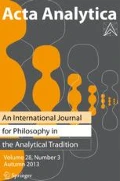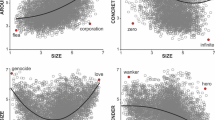Abstract
Some entities, such as fictional characters, propositions, properties, events and numbers are prima facie promising candidates for owing their existence to our linguistic and conceptual practices. However, it is notoriously hard to pin down just what sets such allegedly “language-created” entities apart from ordinary entities. The present paper considers some of the features that are supposed to distinguish between entities of the two kinds and argues that, on an independently plausible account of what it takes to individuate objects, the criteria let in more than friends of the strategy might be happy with.
Similar content being viewed by others
Notes
For instance, Amie Thomasson has identified various different ways in which the strategy allows us to see entities as language-created (Thomasson 2001). Thomas Hofweber has argued that the characteristic uses of referring expressions that Schiffer and others take to be responsible for the “creation” of entities serve a different communicative function so that the strategy fails (Hofweber 2007). Luca Moretti defends Schiffer’s strategy and provides a general account of the features of the entities constructed by linguistic practices (Moretti 2008).
Moretti briefly discusses this question (Moretti 2008) but, to my mind, ends up being too optimistic on behalf of the constructivist.
Crawford Elder has recently criticized this strategy of rendering linguistic constructivism compatible with the platitude that if properties exist at all, they existed before humans started engaging in any linguistic practices and they would have existed even if no language-using creatures ever had (Elder 2006). Elsewhere, I have developed an account that allows the linguistic constructivist to resist Elder’s criticism (Einheuser 2006).
Schiffer is quoting from Johnston (1988).
A sortal concept, expressed by a sortal term, is a concept that conveys both criteria of application and criteria of identity governing the objects that fall under it. The Stanford Encyclopedia entry on sortals (Grandy 2007) provides an informative overview.
See Jonathan Lowe’s recent defense of this view against a series of objections in his Lowe (2007).
Again, see Lowe (2007) for a defense of this sort of claim.
Amie Thomasson, in Thomasson (2007), has made a convincing case for why we need to conceive of our terms as associated with sortal concepts, though she talks of criteria of application and co-application rather than of sortals.
References
Einheuser, I. (2006). Counterconventional conditionals. Philosophical Studies, 127(3), 459–482.
Elder, C. L. (2006). Conventionalism and realism-imitating counterfactuals. Philosophical Quarterly, 56, 1–15.
Grandy, R. (2007). Sortals. The Stanford encyclopedia of philosophy. Available at http://plato.stanford.edu/entries/sortals/. Cited 2 May 2009.
Hofweber, T. (2007). Innocent statements and their metaphysically loaded counterparts. Philosophers’ Imprint, 1, 1–33.
Johnston, M. (1988). The end of the theory of meaning. Mind and Language, 3(1), 28–42.
Kripke, S. (1972). Naming and necessity. In D. Davidson & G. Harman (Eds.), Semantics of natural language (pp. 253–355). Dordrecht: Reidel.
Lowe, E. (2007). Sortals and the individuation of objects. Mind and Language, 22(5), 514–533.
Moretti, L. (2008). The ontological status of minimal entities. Philosophical Studies, 141, 97–114.
Schiffer, S. (1996). Language-created, language-independent entities. Philosophical Topics, 24(1), 149–167.
Schiffer, S. (2003). The things we mean. Oxford University Press.
Thomasson, A. (2001). Ontological minimalism. American Philosophical Quarterly, 38, 319–331.
Thomasson, A. (2007). Ordinary objects. Oxford University Press.
Author information
Authors and Affiliations
Corresponding author
Rights and permissions
About this article
Cite this article
Einheuser, I. Some Remarks on “Language-Created Entities”. Acta Anal 24, 185–192 (2009). https://doi.org/10.1007/s12136-009-0052-6
Received:
Accepted:
Published:
Issue Date:
DOI: https://doi.org/10.1007/s12136-009-0052-6



